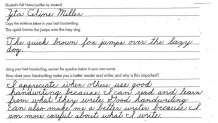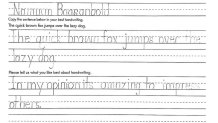
It’s regarded, hands down, as the Super Bowl of penmanship tournaments.
The Zaner-Bloser National Handwriting Contest, now in its 33rd year, crowned its 2024 grand champions on Monday, rewarding nine students from six states for their picture-perfect letters.
Ten-year old Zita Miller of White Bear Lake, Minnesota, took top honors in the fifth grade category. Her winning submission was one of the contest’s 80,000 entries.
“I like handwriting because it’s like art, drawing swirls and vines and curls,” Miller said, adding that she enjoys penning original mystery stories by hand.
Get a weekly recap of the latest San Francisco Bay Area housing news. Sign up for NBC Bay Area’s Housing Deconstructed newsletter.


Namuun Baasanbold, from Carmel, Indiana, was named grand champion in the first grade category, and said she likes to give handwritten “love notes” to family and friends.
U.S. & World
“Writing by hand makes me feel special,” she said.
The contest celebrates a centuries-old practice, but the victories come as handwriting is experiencing a kind of renaissance in the U.S. In January, California became the 22nd state to require cursive to be taught in schools — a significant jump from 2016, when just 12 states mandated it.
At the same time, various studies published over the past decade have detailed how writing with pencil and paper can benefit memory, cognitive development, reading comprehension and fine motor skills.
“Handwriting is definitely having a moment,” said Sharon Quirk-Silva, a member of the California state Assembly who sponsored the bill. She said she heard from people from all over the country who penned “beautifully handwritten notes” of support for the new law.
“We live in a very polarized nation. So many issues are contentious. But with this handwriting bill, we had full bipartisan support and goodwill. The importance of handwriting is something people seem to agree on,” she said.
Quirk-Silva said she backed the bill, in large part, because of her own experience — before becoming a lawmaker, she taught elementary school for 25 years.
“For years, technology has been taking over the curriculum in schools, with many kids being dormant in front of the screen, using two or three screens a day. Now, there’s a feeling of, ‘Let’s get pens and pencils back in kids’ hands,’” she said.
Although the California law mandates that first through sixth graders in the state receive cursive instruction, Quirk-Silva said she believes that writing by hand — in print or cursive — is an important language arts tool.
“It’s a way of slowing down a little bit, taking your thoughts from your brain to your hand and physically doing the writing,” she said.
Sophia Vinci-Booher, an assistant professor of psychology and human development at Vanderbilt University, said her research found that writing by hand enabled preschool students to form connections in the brain that likely support early letter recognition.
For that study, published in 2016, 20 children were asked to practice certain letters by writing them over and over, and practice others by pressing a button.
“Then we asked the children to go into an MRI scanner and look at those letters they’d been practicing,” Vinci-Booher explained. Her team analyzed the children’s brain activity to assess the functional connectivity between different areas of their brains.
“We found that the connection was stronger with letters they wrote by hand than those they tapped,” she said.
The research underscores the importance of the physical act of forming symbols, Vinci-Booher added.
“Writing by hand is a good thing for kids because it supports early reading development and it engages the fine motor system, which is developmentally important,” she said.
A 2021 study measured people’s brain activity during a memory task, this time finding that University of Tokyo students exhibited stronger activity and better recall after they had written information down on paper than when they did on a smartphone or even with a stylus on a tablet. The researchers suggested that the physical act of writing on paper provides the brain more details that trigger memory, and concluded that using paper notebooks can help students retain information in part because of their “tangible permanence.”
A similar study published in January compared the brain activity of students at the Norwegian University of Science and Technology who took notes by hand to the activity of those who typed their notes. The findings suggested that the students who wrote by hand had higher levels of electrical activity across a wide range of brain regions responsible for sensory processing and memory.
The results come as little surprise to many educators.
“I’ve seen firsthand that the kids learn more when they write by hand,” said Geeta Kadakia, who teaches second through fifth grade at the DAV Montessori School in Houston. “The lightbulb goes off through those achievements in handwriting, and handwriting leads to achievements in other areas, even math. When students make their numbers more neatly, their math scores improve.”
Laura Gajderowicz taught elementary school for 33 years in Indiana before retiring in 2022. She said she worried as she watched handwriting take a back seat to technology in U.S. classrooms in the early 2000s.
“Writing by hand does so much to help with the development of a student’s eye-hand coordination,” Gajderowicz said, adding: “I’m not against technology — I just think there’s a place at the table for both technology and handwriting when it comes to learning.”
This year, Gajderowicz served as a regional judge in the Zaner-Bloser contest.
“I was pleasantly surprised to see how many entries we had, especially from children in the upper grades,” she said.
Gajderowicz selected winners using criteria that analyzed the mechanics and precision of the letters students wrote, including their shapes, sizes, slant and spacing.
Contestants were asked to write the sentence, “The quick brown fox jumps over the lazy dog,” because it includes the entire alphabet, as well as a sentence explaining why handwriting makes them a better reader and writer.

Baasanbold said she was “over the moon” to find out she won: “I screamed and celebrated with friends at a restaurant with pizza and an appetizer and a sundae for dessert,” she said.
Her prizes include a trophy and $500 — plus bragging rights.
“I like to use my handwriting to impress people,” she said.
This article first appeared on NBCNews.com. Read more from NBC News here:



